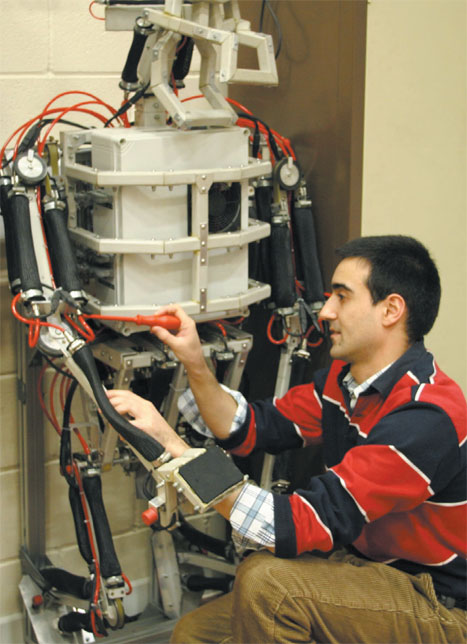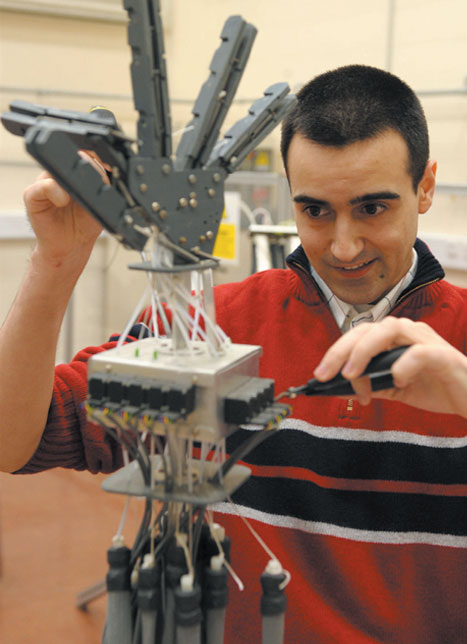From fears of an impending skills shortage to concerns over its ability to engage with the public and attract a new generation of graduates, the UK engineering sector faces a number of well-known and frequently reported challenges.
It’s often tempting to regard these issues as a very British problem: a symptom of a culturally ingrained failure to play to our historic strengths. But as anyone familiar with the wider global engineering community will attest, the challenges faced by the UK are far from unique.

One person better qualified than most to comment on the global state of the profession is Prof Moshe Kam, president and chief executive officer of the IEEE (Institute of Electrical and Electronics Engineers), the world’s largest professional engineering body.
Talking to The Engineer during a recent visit to the UK, Kam provided some welcome international perspective on the trials and tribulations of the global engineering profession.
And of all the issues that trouble the eminent electrical engineer, it is the declining interest of young people in engineering that appears to worry him the most.
’There’s no question that one very serious problem we have is the image of engineering in the eyes of young people,’ said Kam. ’While there is no shortage of engineering candidates for study in China, India and many other developing countries, there is a decline of interest in northern America, western Europe and some other countries, such as South Africa.’
“If you have a teacher who’s afraid of getting in to the lab because they’re not sure what will happen – you are not inspiring young people to follow”
Much of the blame for this, he claims, lies with engineering educators, who have consistently failed to capitalise on the subject’s ability to excite and inspire. ’Think of the way physicians represent themselves or websites that advise young people on careers describe them,’ he said. ’They are seen as individuals who save lives, they eradicate plagues, they aid humanity. They do not concentrate on the struggles to get the accounting right with the insurers. Somehow in engineering we fail to convey to young people the sense that engineering is actually a noble profession.’
One of the ways the IEEE is helping to address this perception gap is through its Try Engineering initiative (www.tryengineering.org). Jointly developed with IBM, the website is a laudable attempt to explain to students, parents, teachers and the general public what engineers actually do, as well as to demystify the route into an engineering career. According to Kam, the website is receiving around six million hits a year.
Engaging with teachers, Kam believes, is particularly important. ’Increasingly, teachers of young students have no direct connection to engineering. Many science teachers don’t even have a degree and in some cases are more or less general practitioners, who are asked to teach this or that. If you have a teacher of physics who’s a little bit afraid of getting in to the physics lab because they’re not sure what will happen you are not inspiring young people to follow.’

The IEEE’s teacher in-service programme which encourages skilled volunteers to work with teachers on engineering lessons is, said Kam, one model that could help build grassroots enthusiasm and understanding. ’We are looking for volunteers who are parents of young children and we’re trying to educate them to work with teachers, so that they can take a class of 30 students and devise a set of classes that will end with them building something,’ he explained. ’We are trying to bring a sense of creativeness, joy and intellectual challenge to young people, so that they look at engineering and see it is interesting. It’s something all engineering associations need to be engaged in if we are to start making a difference.’
And it’s critical, he added, that this engagement occurs as early as possible. ’By the time they get to university it’s too late we really need to catch them early. Many [students], because of lack of understanding, are making selections of classes that, by the time they are 14, completely block the way into an engineering or technology programme.’
“By the time they get to university it’s too late – we really need to catch them early”
But the responsibility to affect change doesn’t lie with educators alone. Indeed, policy makers also have a major role to play in creating the right climate, said Kam.
’In terms of policy, trying to put more individuals with education in the sciences and engineering in the pre-university systems has almost not been on the radar of any government. Those who are responsible for the education of those who will teach future engineers are almost totally disconnected if I had one dollar to invest and you asked me where to put it, it is there.’

One popularly held belief for the reason that engineering has a perception problem is the fact that engineers don’t have a universally protected status such as doctors benefit from. But while Kam agreed this could help, he suggested that the engineering industry has not earned the right to insist on this sort of protection. ’With exclusive status comes an increased social obligation. For instance, if I fall ill today, show at the hospital and have no money to pay for it, they are not going to send me away. If I am sued and I don’t have money to pay, a lawyer will be assigned to me. We have not yet developed an engineering ethos that if, say, an impoverished community needs to build a kindergarten or school, it will go to the local civil engineering firm and say, “you do the following pro bono work for me because you owe me due to your protected status”. Protected status is good, but it’s a social contract if we want to do it we need to commit to the whole package. Engineers speak about one part of it but not the other. What are we giving back to society in exchange?’ It’s a perspective that will almost certainly throw fresh fuel on a debate that never ends.
Moshe Kam - biography
President and chief executive officer of the IEEE
Education
- 1972-1976 Degree in Electrical Engineering at Tel Aviv University, Israel
- 1983-1984 MSc in Electrical Engineering, Drexel University, Philadelphia
- 1984-1986 PhD in Electrical Engineering, Drexel University, Philadelphia
Career
- 1987-2001 Professor of Electrical and Computer Engineering, Drexel University
- 2001-2007 Head of the Electrical and Computer Engineering department
IEEE positions
- 2003-2007 Member of the IEEE Board of Directors
- 2005-2007 Vice president, Educational Activities
- 2008-2009 Chair, Committee on Global Accreditation Activities
- 2009 Chair, New Initiatives Committee
- 2011 President and chief executive officer of the IEEE
Q&A - Bringing engineering to life
From your international perspective, how important is the flow of overseas students to the health of the global engineering community?
The experience that both the UK and US have with foreign students has, in my opinion, been a total success story because of the fact that some of them remain and some of them go back.
Those that go back usually take with them an affinity to the country where they were educated. And when they become very important in their own country they usually tend to work with the schools and organisations in the country in which they were educated.
There is no indication that foreign students have created a suppression of salaries for engineers, or that they have joined the welfare class upon graduation. From time to time, politicians in the US and UK tend, for rhetorical reasons, to look at foreign students as if they were some kind of menace or enemy but attempts to curb it bring solace or benefit to no one. If they don’t come to you, they are not going to disappear they are going to find the next best opportunity. Anyone that turns them away makes a mistake.
Where do you think the really exciting opportunities will be for the next generation of young engineers?
If you ask me where engineers will be in the next 20 or 30 years, [then I would propose that] we will be at the intersection of electrical engineering, computer science and computer engineering with the life sciences.
This is where all the excitement is and, because we have made such strides in the last few years in life sciences, which have had a such an impact on healthcare, [we have shown that] engineers can do a lot. A lot of the work done in other areas, such as signal processing and radar, is now used in areas such as predictive toxicology.
One of the areas where I think we will play an increasingly major role is individualised medicine, which requires significant computations, detection and estimation young men and women should know that this is where they will be going not more missiles.’
The other area is [that concerning] safer, cleaner energy in the whole exhilarating enterprise of the smart grid the idea that you will be able to amass resources such that at night and when you’re at work and your car is idle you [will be able to] charge your car. Maybe when industry needs more power we will take the peak out of the millions of batteries around, rather than creating another fossil-fuel generating station.
What do you make of the UK government’s policy on engineering and research?
All our experience shows that making alliances between university and industry smoother is good for innovation and the economy; you need strong universities. I’m glad to see some of the actions that have been taken. In the UK and US there are too many legal obstacles to co-operation due to IP issues and this is one area where the government can intervene and make life easier for everybody.












Water Sector Talent Exodus Could Cripple The Sector
Maybe if things are essential for the running of a country and we want to pay a fair price we should be running these utilities on a not for profit...